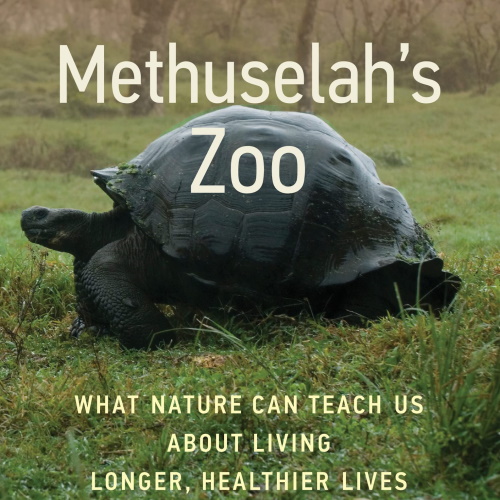Methuselah’s Zoo
What Nature Can Teach Us about Living Longer, Healthier Lives, a book written by Steven N. Austad
Stories of long-lived animal species—from thousand-year-old tubeworms to 400-year-old sharks—and what they might teach us about human health and longevity. In Methusaleh’s Zoo, Steven Austad tells the stories of some extraordinary animals, considering why, for example, animal species that fly live longer than earthbound species and why animals found in the ocean live longest of all.
Austad—the leading authority on longevity in animals—argues that the best way we will learn from these long-lived animals is by studying them in the wild. Accordingly, he proceeds habitat by habitat, examining animals that spend most of their lives in the air, comparing insects, birds, and bats; animals that live on, and under, the ground—from mole rats to elephants; and animals that live in the sea, including quahogs, carp, and dolphins.
Mini Review
The book goes into quite a bit of detail about the animals themselves, not just about their longevity (though who really knows what is relevant), but it's all interesting information.
Austad is particularly good at debunking myths of unusually long lived specimens (which he explains provides lots of good publicity to the zoos) - much of the time based on conflicting evidence that he has personally unearthed.
Key Points
Birds & Insects
- birds in nature somehow seem to remain physically fit to the very end of their lives
- your body manufactures a rather miraculous two thousand miles of new DNA per second just to replace the DNA it lost in discarded cells
- total weight of HeLa cells grown from Lacks’s original biopsy in medical laboratories is now said to have exceeded twenty tons
- a single fertilized egg can create a healthy trillion-celled young adult dog or dove or dolphin
- in the United States only about one person in twenty now dies before age fifty.
- mice cells has a metabolic rate (i.e. it burns energy) fifteen times faster than those from a horse
- a species longevity quotient LQ is its longevity measured under protected conditions
- dogs have an LQ of just about exactly 1 - very average mammals from longevity standpoint
- best way to live an exceptionally long life is to be born where illiteracy is common and reliable birth records are not
- flight in insects is not associated with exceptional longevity
- insects only gain the ability to fly as adults
- wing damage likely limits the lives of insects in nature
- endothermy (being warm blooded) requires a human to eat about 25 times as much food as a human-size alligator
- birds living in the wild survive about three times as long as similar-size mammals in a zoo
- delayed, slow reproduction is a feature of animals with exceptional longevity
- even with birds’ higher body temperature and elevated blood sugar concentration, their tendons, ligaments, and other tissues don't brown at a much higher rate than mammals
Bats, Bees and Turtles
- there are more than a thousand living bat species, accounting for about a fifth of all mammals
- little brown bats, animals one-third the weight of a mouse, could live at least thirty- four years (LQ > 7.5)
- researchers focused on bat biology could discover nature’s secrets for substantially extending health
- most turtles and tortoises seem to take a long time to become adults, then tend to go on and on
- tuataras (reptiles endemic to New Zealand) have a LQ of about 10.3
- giant tortoises and tuataras process only a fraction of the energy during their long lives compared to humans
- genome sequences of long-lived tortoises suggests that DNA damage repair and cellular resistance to cancerous transformation may contribute to their exceptional longevity
- insect queens live in robust health an extraordinarily long time
- ant and termite queens can live as long as several decades
- sister bees are closer relatives to one another than they are to their parents
- species occupying environmental niches protect them from external hazards live a long time
- queens have much more active cellular damage prevention and repair genes turned on than workers
- a single gene, ILP-2 (insulin-like peptide 2), was highly active in ant queens but not in workers
- long-lived ant queens have increased insulin-like activity relative to shorter-lived workers
- but increased longevity in laboratory species is accomplished by reducing the activity of insulin-like genes
Rodents
- record longevity for a naked mole-rat is thirty-nine years (LQ = 6.7)
- NMRs do not seem much more likely to die as they grow older, at least into their twenties
- unbridled cell division is cancer — a price species pay for their ability to continue cell division throughout life to repair or replace damaged parts
- Rochelle Buffenstein noticed that she never found tumors in thousands of deceased NMRs
- the special form of hyaluronic acid that NMRs manufacture can make mouse cells in a dish display some of the same cancer resistance
- at the same age, they have more oxygen radical damage than mice!
- spalax can live at least twenty-one years in the lab and show virtually no signs of aging, and are even more cancer-resistant than NMRs
- naked mole-rat burrows can have as little as 6 percent oxygen and as much as 10 percent carbon dioxide
- defenses against oxygen and carbon dioxide stress may also protect against more normal internal dangers such as damage to DNA and other cellular components
- zoos report olms to live up to seventy years (LQ between 14 and 21)
Elephants & Primates
- tooth wear may be what limits the lifespan of elephants
- elephants have a unique type of cancer prevention = TP53 (tumor protein, 53 describes its size)
- more than half of all human cancers have mutated TP53
- we have one copy of TP53 inherited from each parent, but African elephants have twenty copies
- lower levels of DNA damage to elephant cells activates TP53 and flips the cellular suicide switch
- whales do not have extra copies of TP53
- primates have the highest longevity quotients of any major group of mammals other than bats
- hearts weigh about 0.5 % of total body weight whether you are a mouse, a moose, or a sperm whale
- heart, liver, kidney, and spleen size correlated with species longevity
- cerebellar size and number of neurons could potentially be involved in longevity
- brain weight and volume are poor predictors of neuron number (their size vary enormously)
- humans have three times as many neurons in their cortex than elephants in their much larger cortex
- bats are similarly poorly endowed in their cortex
- handful of chimpanzees make it into their sixties, possibly even their late sixties
- if they survive to adulthood, orangutans average about thirty- five years
- smaller individuals often live longer within a species
- species have a single LQ averaging the size of the sexes
- primates as a group have a slow metabolism
- brain size helps reduce environmental dangers for primates
Fish, Sharks and Whales
- near impossible to be endothermic and live in the deep ocean because water is very efficient at wicking heat away from warm bodies
- exceptional longevity of at least a century or more has been documented in several tubeworm species the oldest escarpia laminata would have been only a whisker over a thousand years old
- red sea urchins have an exceptionally low metabolic rate and live more than a century
- older urchins are no more likely to die than younger ones,
- Ming was an ocean quahog born in the year 1499
- Arctica’s protein protection machinery worked better than any other clam - which could lead to treatments for protein-misfolding diseases like Alzheimer’s and Parkinson’s disease
- as far as we know, sturgeons don’t age
- the oldest sturgeon of any species aged by fin rays is a 152-year-old lake sturgeon (Acipenser fulvescens)
- at least six rockfish species live a century or more
- rougheye is the longest-lived rockfish (205 years)
- Greenland shark (Somniosus microcephalus) found to be 335 and 392 years old (based on chemical analysis of the eye lens) - LQ = 2.2
- Sarasota Bay dolphins have two to three times the metabolic rate of a terrestrial mammal of the same size
- killer whales a longevity quotient of 1.6.
- seasonal ear wax production captures many aspects of an individual whale’s life
- oldest bowhead whale was judged to be 211 years old,
- whales’ genomes suggest that they have some special tumor-suppressor genes
Human Longevity
- about 80 percent of our Neanderthal cousins, who managed to reach age twenty, were dead by age forty
- during European colonization of the Americas 90 percent of indigenous people died from introduced diseases
- in 1900 France life expectancy was forty-five years because of high infant and childhood mortality, but the most common age for adults to die was the early seventies
- humans in the wild just a bit longer-lived than elephants, giving them a longevity quotient of 3.8
- cardiovascular diseases and osteoporosis are virtually unknown in hunter-gatherers
- exceptional bone density found in hunter-gatherers that protect against osteoporosis
- evolutionary puzzle: why do women’s ovaries age so much faster than the rest of their body
- in Sweden, infant mortality today is more than fifty times lower than what it was in 1900.
- women live longer than men at every time and in every place where good records are available.
- being the oldest living person is the most dangerous job in the world - usually being killed on the job within a few months
- human biology may have already solved whatever problems limit a mouse’s life
- stands by his 2001 statement that the first person to live to 150 is already alive
Visit website: https://mitpress.mit.edu/9780262047098/methuselahs-zoo/
Details last updated 19-Nov-2022





